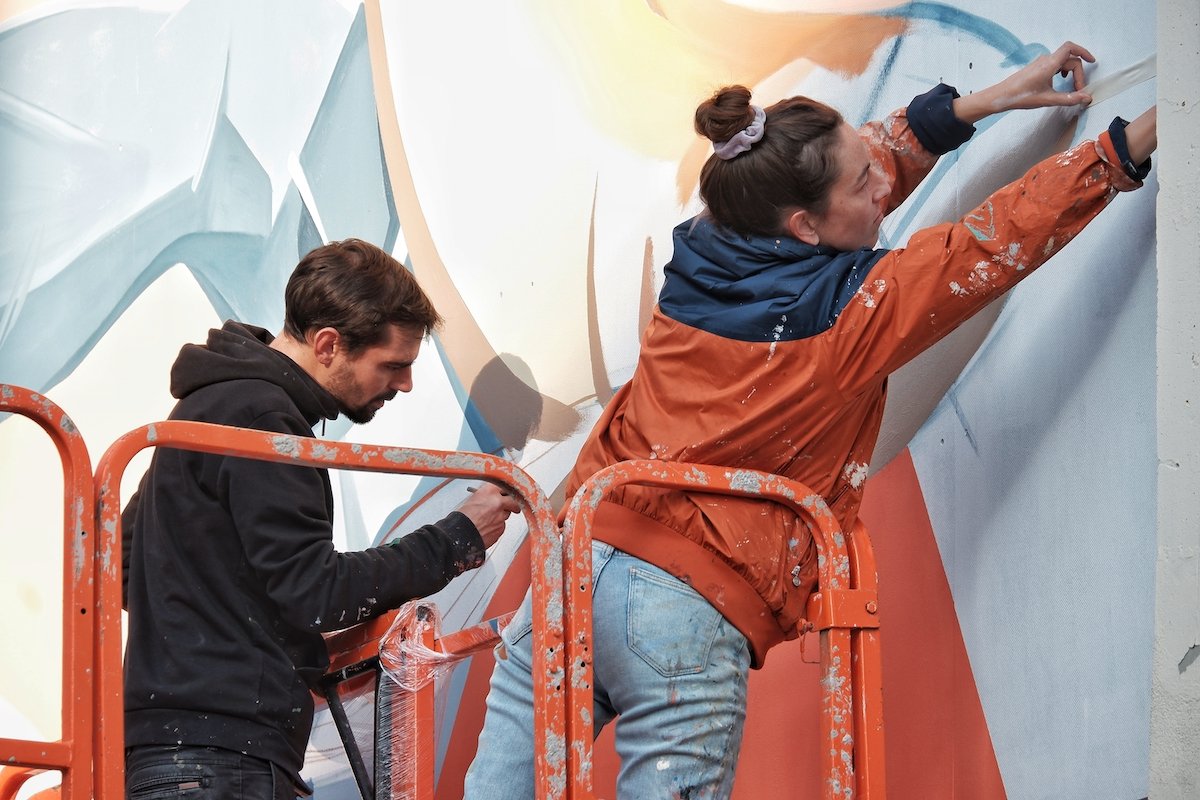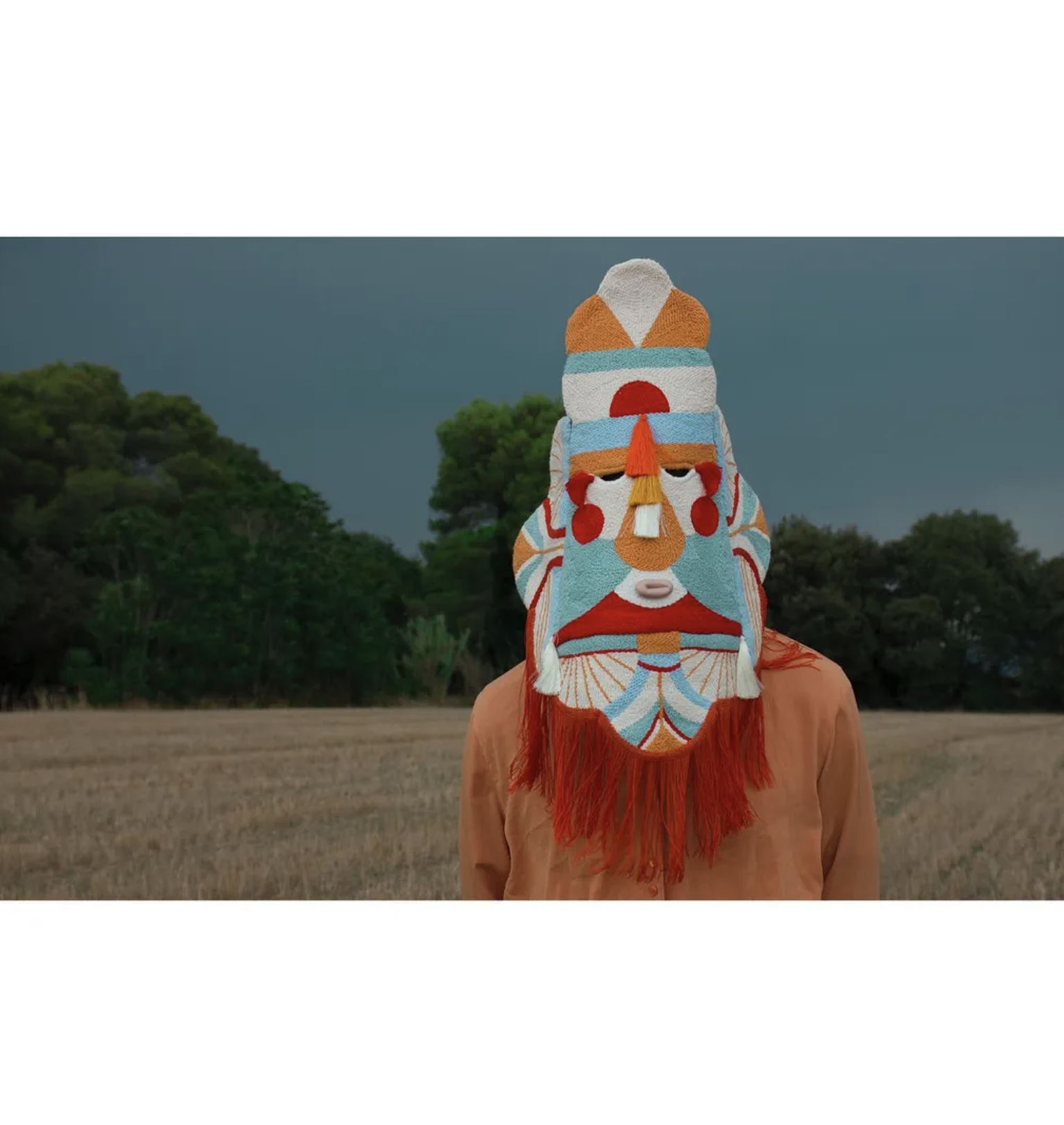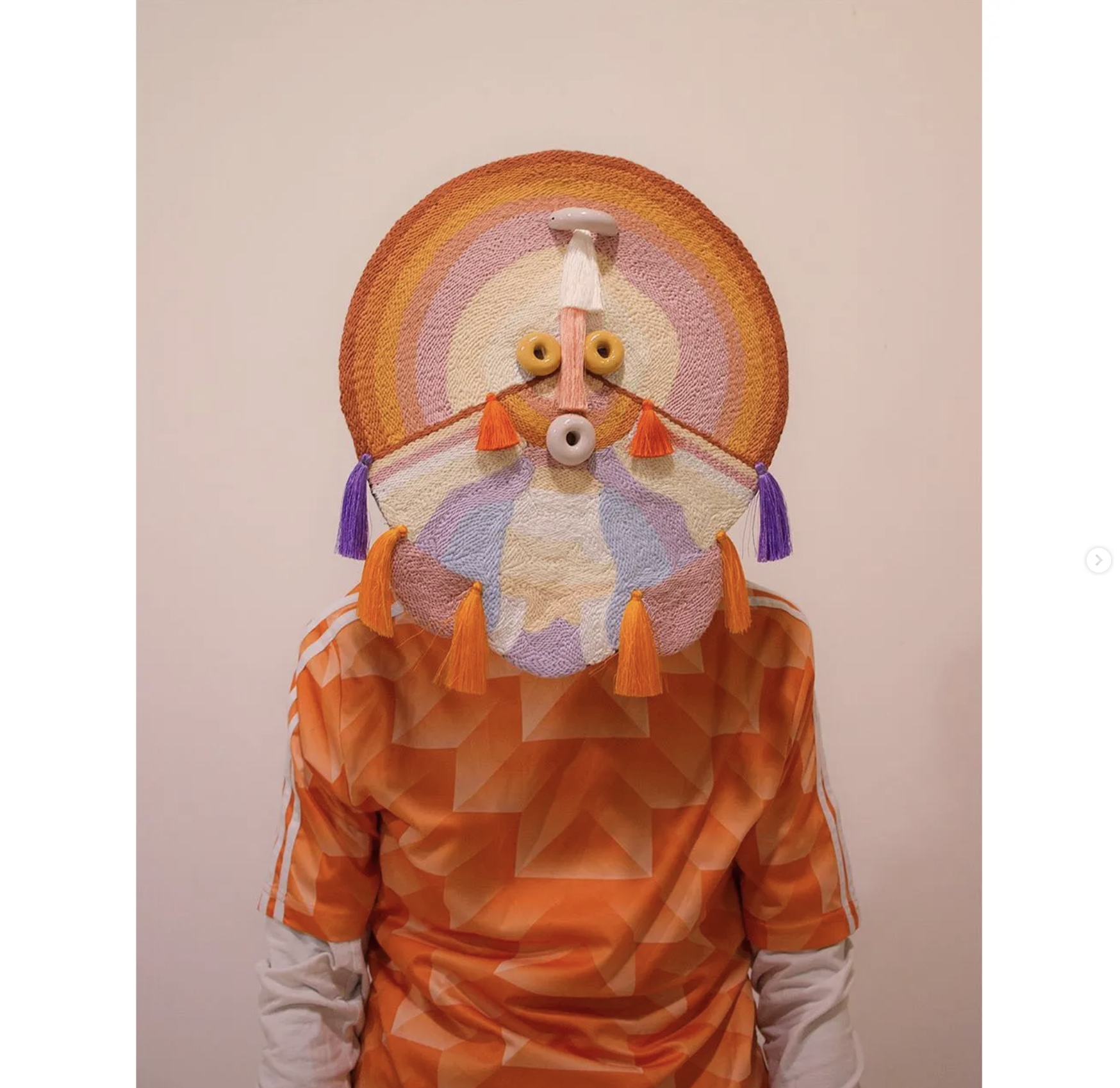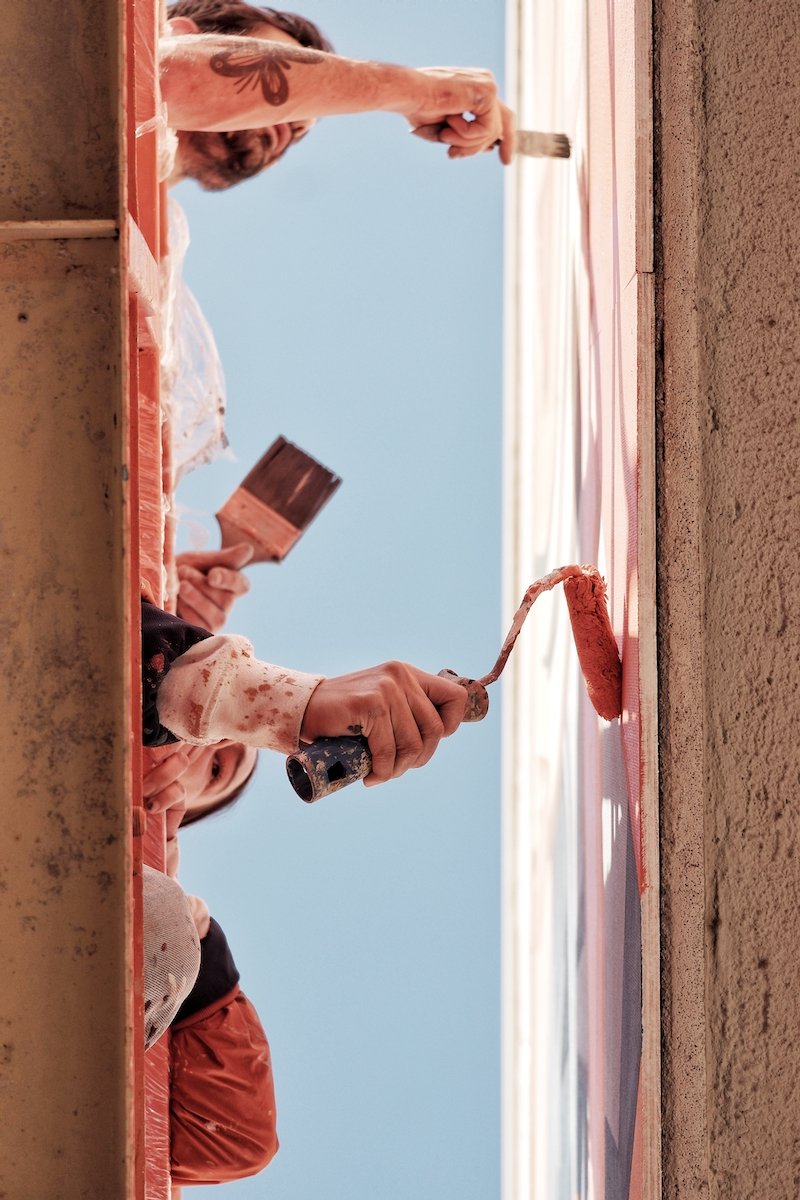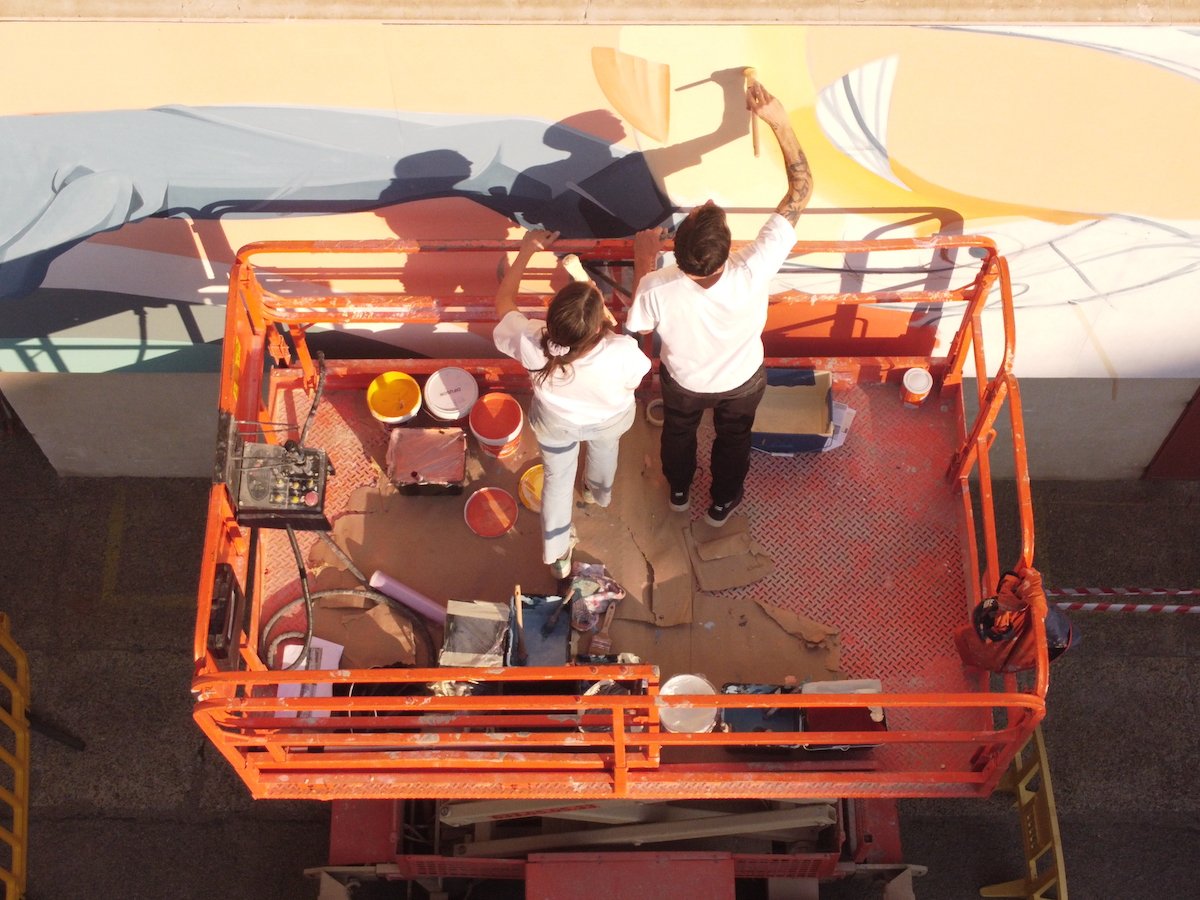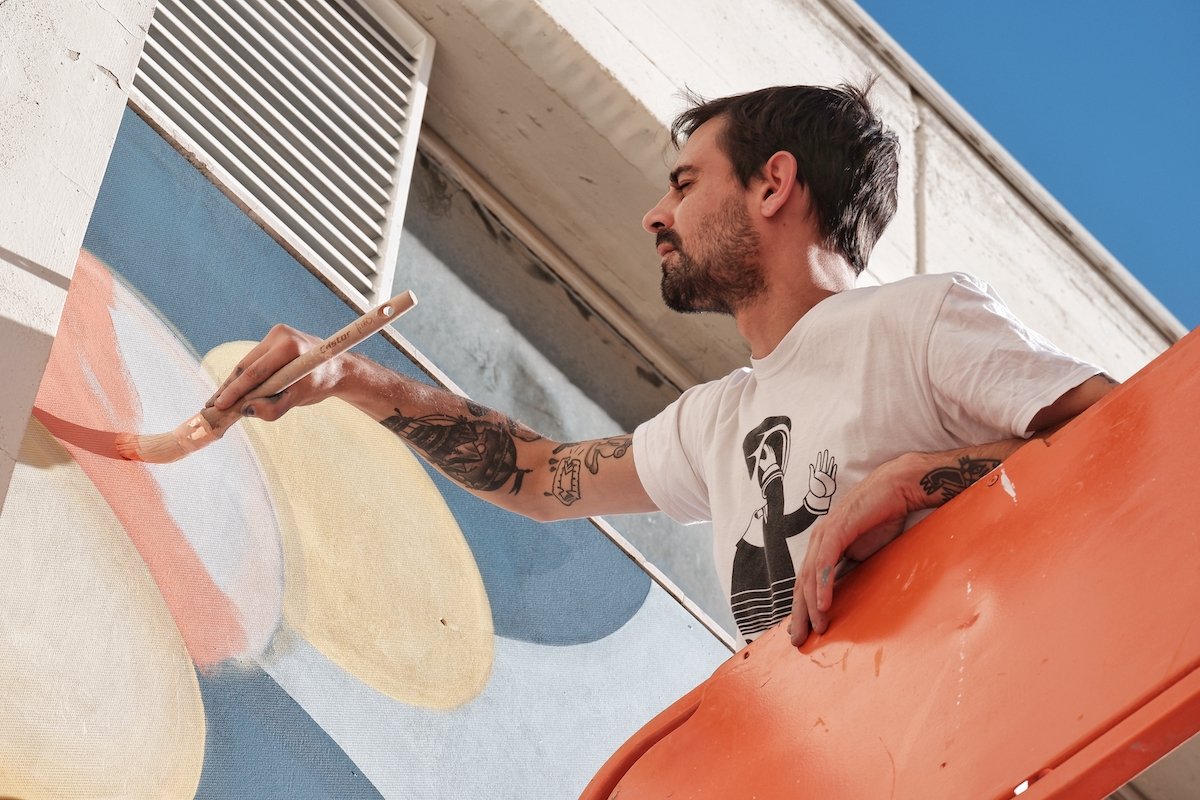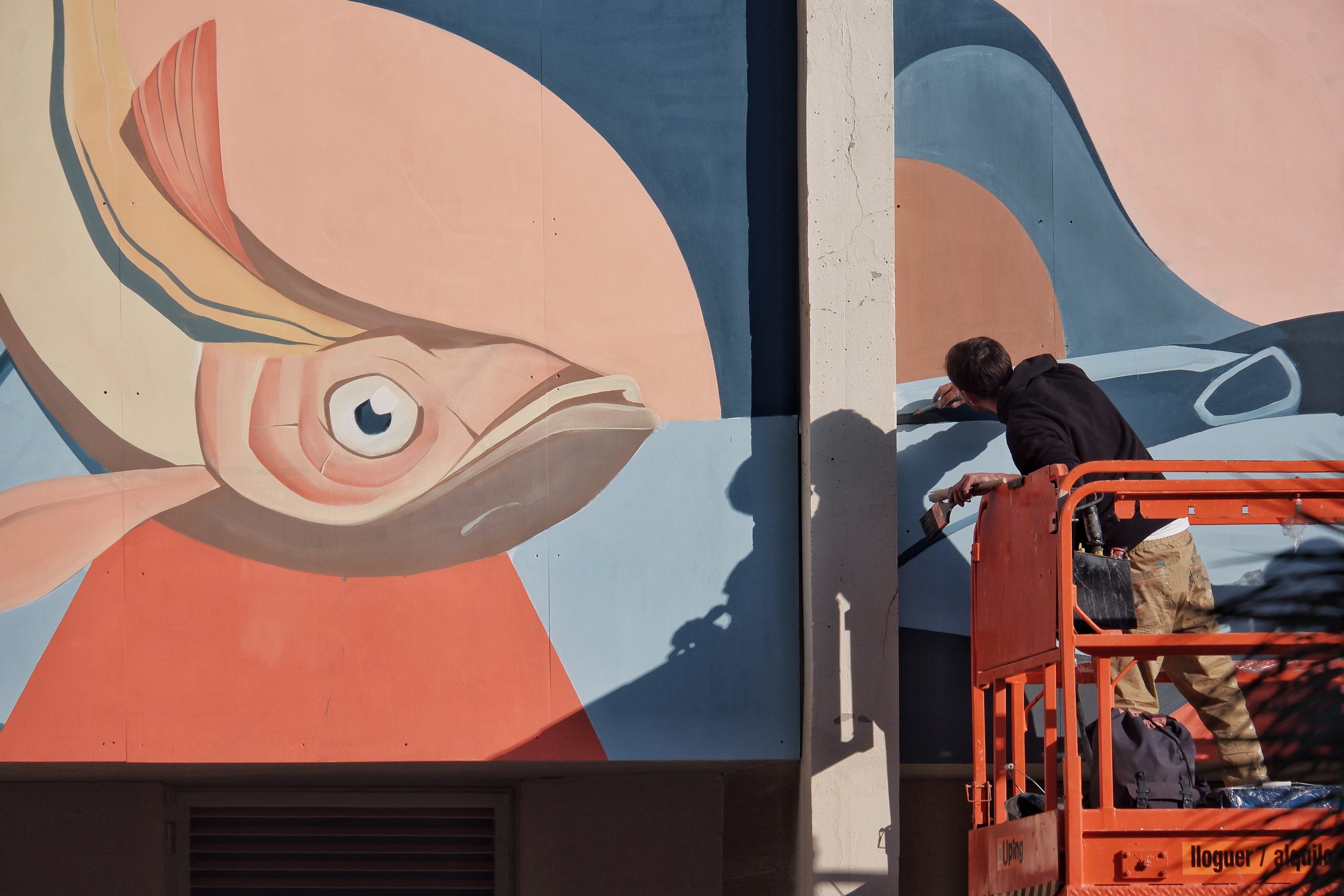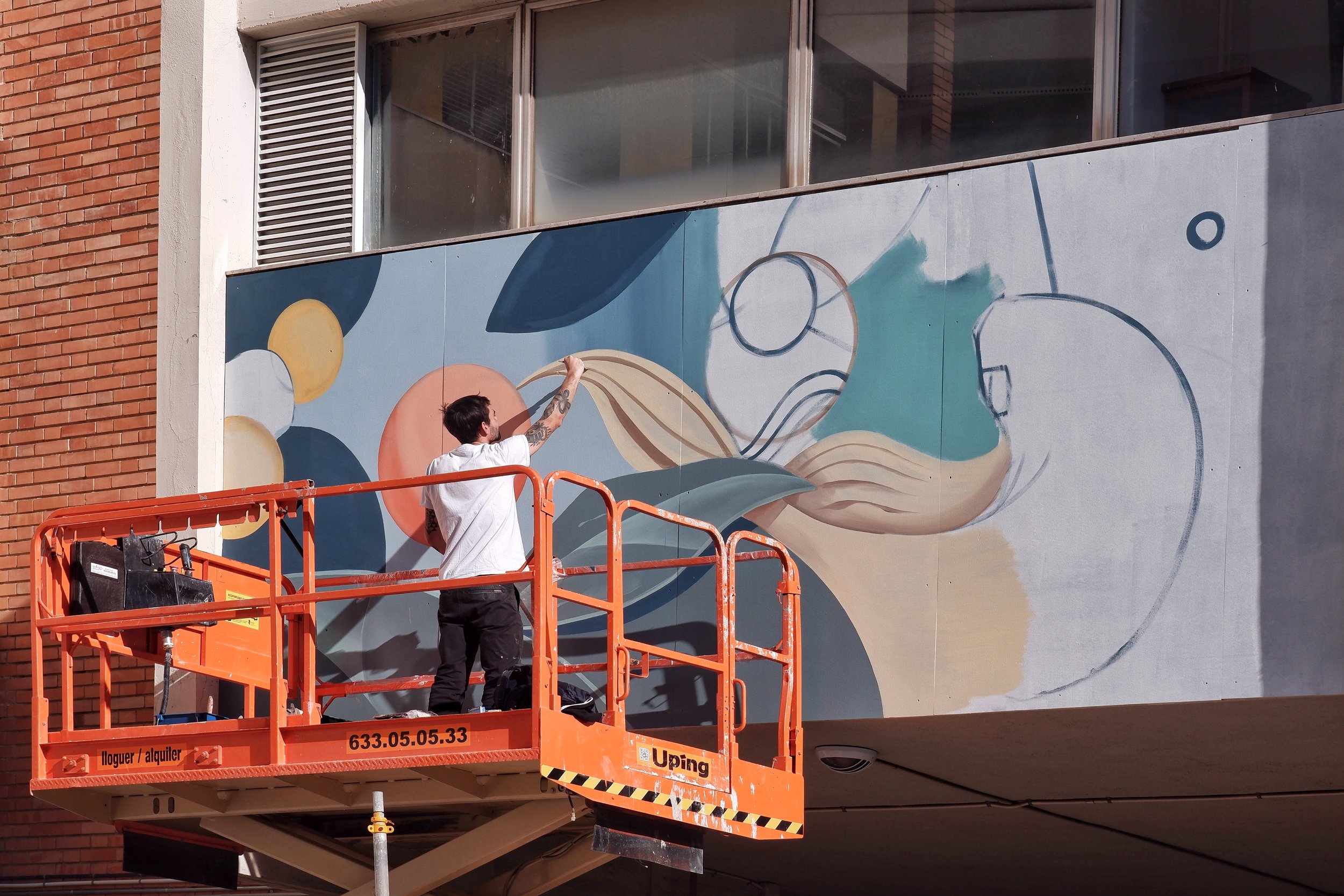ENTREVISTA CON TWEE MUIZEN
Twee Muizen (‘dos ratones’ en holandés), es un dúo artístico gallego formado por Cris y Denís, una pareja que decidió cambiar su trayectoria laboral y explorar su creatividad en un proyecto artístico conjunto.
Denís estudió Bellas Artes y Cris diseño de moda, dos disciplinas que combinan en sus art toys, ilustraciones y pinturas para crear un universo onírico, fantástico y lleno de naturaleza.
Recientemente, participaron en el proyecto BCN Arte y ambiente de IDAEA-CSIC junto a B- Murals, para unir arte, ciencia y perspectiva de género y plasmarlo en un mural colaborativo en las paredes del Instituto de Diagnóstico Ambiental y Estudios del Agua (IDAEA).
Twee Muizen ('two mice' in Dutch), is a Galician artistic duo formed by Cris and Denís, a couple who decided to change their career paths and explore their creativity in their artistic project.
Denís studied Fine Arts, and Cris Fashion Design, two disciplines that they combine in their art toys, illustrations, and paintings to create a dreamlike, fantastic universe full of nature.
Recently, they participated in the BCN Arte y ambiente project by IDAEA-CSIC, together with B-Murals, to connect art, science, and gender perspective in a collaborative mural on the walls of the Instituto de Diagnóstico Ambiental y Estudios del Agua (IDAEA).
PARTE 1: LA OBRA DE TWEE MUIZEN
PART 1: THE WORK OF TWEE MUIZEN
En vuestra obra usáis disciplinas muy diferentes, Cris trabaja a partir de materiales textiles, y Denís, más bien, se basa en el trazo y la ilustración en diferentes soportes. Aun así, en vuestras diferencias sois complementarios. ¿Estáis de acuerdo o es solo una frase hecha? ¿Queréis comentarlo un poco?
Cris: La complementariedad que tenemos Denís y yo se ha creado de forma natural, trabajando tantos años juntos. Al trabajar con técnicas totalmente diferentes, en algunas cosas nuestros caminos se separan un poco, pero siempre volvemos a encontrarnos. Siempre estamos pensando en Twee Muizen.
Denís: Claro, y también al estar compartiendo a la vez taller y vida, cuando trabajamos en proyectos más individuales (por ejemplo yo con la ilustración y Cris con las máscaras) siempre nos pedimos consejo o nos echamos una mano en algo. Cuando hacemos exposiciones lo hacemos de la misma manera. Intentamos enlazar todas las técnicas que tenemos, tanto con el colorido, las fórmulas, los conceptos... Creo que nuestros trabajos sí se complementan el uno al otro, pero funcionan también individualmente.
In your work you combine very different disciplines, Cris works with textile materials, and Denís, instead, focuses more on drawing and illustrating on different supports. Even so, in your differences you are complementary. Do you agree or is that just a cliché? Would you like to comment on this a little?
Cris: The complementarity that Denís and I have has come about naturally, working together for so many years. As we work with totally different techniques, in some things our paths separate a bit, but we always meet again. We are always thinking about Twee Muizen.
Denís: Of course, and since we are sharing our workshop and our lives at the same time, when we work on more individual projects (for example me with illustration and Cris with the masks) we are always asking each other for advice or helping each other with something. When we do exhibitions we do it in the same way. We try to link all the techniques we work with, both with the coloring, the formulas, the concepts.... I think our respective creations complement each other, but they also work individually.
Cris, tus máscaras representan un patrimonio importante de la cultura gallega.
Es una fuente de inspiración y el punto de partida para una interpretación contemporánea. ¿Sientes que con ello estás llevando la cultura gallega a un nivel internacional?
Cris: El punto de partida de las máscaras era una reflexión alrededor del diseño de personajes. Buscaba llevar el cánon establecido de un rostro de persona a algo totalmente diferente.
Entonces, encontré un retal de pelo con la forma de una barbilla en el taller y empecé a experimentar con ello. A partir de este elemento construí el resto de la cabeza y desde allí fue evolucionando hasta lo que hacemos ahora.
Creo que como en Galicia tenemos esta tradición tan fuerte del Entroido, tenía este referente en mi subconsciente y las máscaras han ido evolucionando naturalmente hacia esta estética.
Cris, your masks represent an important heritage of Galician culture.
It is a source of inspiration and the starting point for a contemporary interpretation. Do you feel that you are taking Galician culture to an international level?
Cris: The starting point behind the masks was a reflection about character design. I wanted to take the established canon of a person's face and turn it into something completely different.
Then, I found a piece of hair shaped like a chin in the workshop and I started experimenting with it. From this element I built the rest of the head, and from there it evolved into what we do now.
I think that because in Galicia we have such a strong tradition of the Entroido, I had this reference in my subconscious and the masks have evolved naturally towards this aesthetic.
¿Haces algún tipo de investigación más del foro antropológico o del folclore gallego, o son conocimientos que tienes incorporados a raíz de tus experiencias vitales?
Cris: Cuando reconocí la estética gallega en mi trabajo, ya que todo el mundo relacionaba mis máscaras con el folclore gallego, empecé a fijarme más en la tradición gallega y a investigar; no solo los trajes tradicionales, sino también la cerámica y otro tipo de disciplinas. Mis raíces me inspiraron y me guiaron en el proceso. Siempre están presentes en lo que hacemos, pero creo que lo que sirvió de base en la evolución de las máscaras fue el descubrimiento de técnicas de trabajo: el bordado y el trabajo con hilaturas son lo que han ido resonando en segundo lugar con mis orígenes.
Algo guay y sorprendente ha sido que cada uno se lo lleva a su terreno y lo relaciona con su propio folclore. Por ejemplo, mis amigos de Perú lo relacionan con la tradición del carnaval.
Entonces me puse a investigar y descubrí que tiene un montón de similitudes con culturas muy diversas y que es una forma de expresarse muy rica.
Do you do any further research into the anthropological forum or Galician folklore, or is it knowledge that you have acquired from your life experiences?
Cris: When I recognized the Galician aesthetics in my work, as everyone related my masks with Galician folklore, I started to look more into Galician tradition and to research; not only traditional costumes, but also ceramics and other kinds of disciplines. My roots inspired me and guided me in the process. They are always present in what we do, but I think that what served as a basis in the evolution of the masks was the discovery of new techniques: embroidery and working with yarns are what have been resonating secondly with my origins.
Something cool and surprising has been that everyone takes it to their own territory and links it with their own folklore. For example, my friends in Peru connect it with the tradition of carnival.
Then, I began to investigate and I discovered that it has a lot of similarities with very diverse cultures and that it’s a wonderful way of self-expression.
¿Conoces a otros artistas gallegos que sigan esta misma tendencia?
Cris: Conozco a otros artistas gallegos, pero de otras disciplinas, no tanto del arte textil, y aún menos de máscaras. Son artistas que trabajan más con cerámica o tapices, como por ejemplo la cerámica de Sargadelos.
Hay mucha gente que sigue inspirándose en la tradición gallega, tanto en las formas típicas y diseños gráficos influenciados por la semiótica gallega, como el trisquel, por ejemplo.
Do you know other Galician artists who follow this same trend?
Cris: I know other Galician artists, but in other disciplines, not so much in textile art, and even less in masks. They are artists who work more with ceramics or tapestries, such as Sargadelos ceramics.
There are many people who continue to be inspired by Galician tradition, both in the typical forms and in graphic designs influenced by Galician semiotics, such as the trisquel, for example.
Denís, tu principal forma de expresión es el trazo, ya sea sobre la pared, la piel, o en digital. ¿Cómo explicas las diferencias entre estos mundos? ¿Cómo la vives? ¿Tienes un medio preferido?
Denís: Para mi son técnicas muy distintas. Llevo desde siempre pintando sobre papel y murales. Creo que pinté mi primer mural a los 10 años. Entonces es algo que a lo mejor no es tan novedoso para mí como el tatuaje, algo que era muy nuevo cuando empecé hace 8 años.
Dibujar en el estudio es un proceso más personal, tranquilo, e íntimo. Nadie lo está viendo y no tienes ningún feedback. Lo que ha cambiado está muy relacionado con el tatuaje, donde estableces una relación con la persona.
Los murales nos permiten salir del estudio, cambiar de aire. Al final hay muchos espectadores, el contacto con la gente es más directo. Establecemos conexiones y vínculos con los colectivos locales, y este aspecto es muy enriquecedor. Nunca tuvimos experiencias de feedback muy negativas.
Las disciplinas son muy distintas, pero todas enriquecedoras. Al final hay días en que me gusta más tatuar y otros en que me gusta hacer murales. El cambio de técnica, por otro lado, nos permite dinamizar nuestro trabajo y experimentar con múltiples procedimientos. Es algo que nos gusta mucho.
Denís, your main form of expression is drawing, whether on the wall, on the skin, or on digital. How do you explain the differences between these worlds? How do you experience them? Do you have a preferred method of expression?
Denís: For me they are very different techniques. I have always painted on paper and murals. I think I painted my first mural when I was 10 years old. So it's something that maybe isn't as new to me as tattooing, something that was very new when I started 8 years ago.
Drawing in the studio is a more personal, quiet, intimate process. No one is watching and you don't have any feedback. What has changed is very much related to tattooing, where you establish a relationship with the person.
The murals allow us to get out of the studio, to change our atmosphere. In the end there are a lot of spectators, the contact with people is more direct. We establish connections and bonds with local collectives, and this is very enriching. We have never had very negative feedback experiences.
The disciplines are very different, but all enriching. In the end there are days when I like tattooing more and others when I like making murals. Changing our technique, on the other hand, allows us to dynamise our work and experiment with multiple approaches. It's something we like a lot.
PARTE 2: EL TRABAJO MURAL Y SUS ASPECTOS
PART 2: MURAL WORK AND ITS ASPECTS
En los últimos años, habéis entrado a pasos largos en el mundo del arte urbano. ¿Lo defendéis? ¿Es un terreno que lucháis por conquistar, o más bien al revés- os ha ido conquistando a vosotros?
Denís: Siempre me ha gustado el graffiti. Cuando estudié bellas artes dejé de lado la pintura con espray para centrarme más en mi obra de estudio, pero tanto el graffiti como los murales siempre han sido parte de mi vida.
Empecé de pequeño porque me gustaba. Nunca me imagine que me iba a dedicar a ello.
Por un lado, los murales que hacemos ahora son concertados, tienen una función más decorativa. Es muy distinto de lo que podía hacer en la calle con el graffiti de forma espontánea.
Pero, por otro lado, esta experiencia de la calle con el graffiti me ayuda a la hora de realizar los murales que pintamos con Twee Muizen. No lo podríamos hacer igual sin este bagaje.
Creo que nos conquista más el arte urbano a nosotros. Siempre quisimos hacer murales, pero ahora tenemos mucha demanda para hacer más murales. Ser muralista es un trabajo en el cual cuando más trabajas, más encargos te salen. Un mural te va llevando a otro.
In the last few years, you have entered the world of urban art with giant steps. Do you defend it? Is it a terrain that you are fighting to conquer, or rather the other way round - has it conquered you?
Denís: I've always loved graffiti. When I studied fine arts I put spray painting aside to focus more on my studio work, but both graffiti and murals have always been part of my life.
I started when I was a kid because I liked it. I never imagined I was going to dedicate myself to it.
On the one hand, the murals we do now are commissioned, they have mostly a decorative function. It's very different from what I could do spontaneously in the street with graffiti.
But on the other hand, this experience of the street with graffiti helps me when it comes to making the murals we paint with Twee Muizen. We wouldn't be able to do it the same way without this background.
I think urban art is more appealing to us. We always wanted to do murals, but now we have a lot of demand to do more murals. Being a muralist is a job in which the more you work, the more commissions you get. One mural leads to another.
Cris: Cada mural es un reto nuevo. En el estudio tienes tus materiales, no necesitas nada más.
En cambio, para pintar un mural grande hay que tener toda una infraestructura detrás: que exista la pared, el festival o el proyecto y que te contraten. Y luego hay toda la gestión de material, la grúa, los permisos, etc.
Entonces es un mundo un poco más difícil de acceder y toda la organización que hay detrás de un mural es más compleja. Se disfruta de otra manera, es un proceso más intenso. Cuando trabajamos en un mural solemos estar enfocados días en ello.
Cris: Every mural is a new challenge. In the studio you have your materials, you don't need anything else.
On the other hand, to paint a large mural, you need to have a whole infrastructure behind it: the wall, the festival or the project, and then you have to be hired. And then there's all the management of materials, the crane, the permits, etc.
So this world is a bit more difficult to access and the whole organization behind a mural is more complex. You enjoy it in a different way, it's much more intense. When we work on a mural we are usually focused on it for days.
¿En general, cómo veis la evolución del arte urbano en los últimos años?
Cris: Yo controlo más en hilos y lanas que en espráis y pintura. Cuando trabajamos en murales ayudo más a Denís en este sentido, pero veo que se está haciendo más diverso el mundo de los murales. Hay muchas más opciones y muchos más artistas con estilos muy diferentes.
Antes pintaban unos cuantos artistas y, aunque cada uno tuviese un estilo muy marcado, a lo mejor desde fuera se veía todo muy similar. Y ahora de repente hay más variedad en cuanto a estilos y artistas, y surgen nuevas tendencias.
Por otra parte, antes era una disciplina muy masculina y ahora las mujeres cada vez ganan más su espacio; su terreno. El arte urbano está evolucionando, es algo bonito.
Denís: Sí, y también hay muchas corrientes artísticas que se ven representadas en murales. Por ejemplo, se está llevando la ilustración cada vez más al muralismo, pero también está pasando con el diseño gráfico, como por ejemplo con el lettering. Hay muchas disciplinas que antes no tenían presencia en la calle.
Por otra parte, tiene su lado negativo, las empresas cada vez se involucran más en el arte urbano y es un factor de gentrificación.
Cris: Es verdad, hay aspectos muy positivos, pero siempre tendrá su impacto negativo, sobre todo cuando hay gente que está especulando alrededor de eso. Pero como muralista tampoco nos podemos sentir responsables. No estamos formando parte de este movimiento especulador.
Overall, how do you see the evolution of urban art in recent years?
Cris: I'm more in control of threads and wool than sprays and paint. When we work on murals I help Denís the most in this sense, but I see that the world of murals is becoming more diverse. There are many more options and many more artists with very different styles.
In the past, there were only a few artists painting, and even if each of them had a very distinct style, maybe from the outside it all looked very similar. And now all of a sudden there is more variety in terms of styles and artists, and therefore, new trends emerge.
On the other hand, it used to be a very masculine discipline and now women are increasingly gaining their space; their terrain. Urban art is evolving, it's a beautiful thing.
Denís: There are also many artistic trends that are represented in murals. For example, illustration is increasingly being brought into mural painting, but it is also happening with graphic design, for example with lettering. There are many disciplines that didn't have a presence on the street before.
On the other hand, it has its negative side, companies are becoming more and more involved in urban art and it is becoming a gentrifying factor.
Cris: It's true, there are very positive aspects, but it will always have its negative impact, especially when there are people who are speculating around it. But as muralists we can't feel responsible for this either. We are not part of this movement in which speculation is taking part.
De pequeños murales en Barcelona, a tener una bellísima intervención en el afamado Fórum (BCN, Museu Blau), a ser premiados en Pared (Oviedo), y más recientemente en Zaragoza, en el reconocido Asalto. Dejando la modestia aparte, ¿como retratáis vuestra trayectoria?
Cris: A mí me gusta mirar atrás y contemplar dónde estábamos hace 5 años y dónde hemos llegado. A pesar de que el arte urbano es un mundo difícil y muy competitivo, todos los logros - aunque sean pequeños - van haciendo que nuestra carrera pueda seguir y sobre todo que podamos dedicarnos a eso, que es lo más importante. Y también la pasión que uno tiene para su proyecto, parece que nunca le deja tirar la toalla (risas).
Aunque estuvimos en momentos malos económicamente, lo disfrutamos tanto que siempre intentamos tirar para adelante con el proyecto de la manera que sea. Creo que el reconocimiento se ganó persistiendo, trabajando poco a poco y evolucionando: no hacemos la misma cosa ahora que hace 10 años.
Denís: Sí, durante muchos años ha sido duro. Es muy difícil ser autónomo, tener un pequeño negocio. Ahora disfrutamos el hecho de no tener que preocuparnos para llegar a final de mes. Creo que la evolución va tan poco a poco que a lo mejor desde dentro no lo notamos. Y como artista o creador siempre estamos queriendo mejorar e innovar. A lo mejor es más una evolución orgánica, lo vemos como un logro, pero también nos da humildad.
¿Cuáles han sido algunos de vuestros murales preferidos?
Denís: El del forum que hicimos con B-Murals fue muy guay. Era un mural participativo con varias escuelas del distrito de Sant Martí y trabajamos con casi 200 niños. Se alargó bastante, fueron como dos meses. Hacíamos sesiones en el cole para luego pintar el mural sobre el tema de biodiversidad.
El de Galicia también, que fue como el primer mural grande que pintamos allí en DesOrdes. Es el festival más importante de Galicia, y lo hicimos desde casa. Se hace justo al lado de Santiago que es de donde somos.
El de Alfamén con el festival Asalto, que lo que hacen es llevar el arte mural a los pueblos. Y esto se hizo en Zaragoza.Cris:
Cada uno nos recuerda un momento clave.
En Alfamén la acogida de la gente de allí fue muy buena. Es un pueblo pequeño, y entonces era como si hubieran estado de fiesta la semana que pintamos. Tenían muchas ganas de acogernos y de pasar un buen rato. Me marcó emocionalmente.
La mayoría de las veces participáis en proyectos que están condicionados por una temática, jurado, consenso, opinión alrededor de un boceto que condiciona vuestro trabajo. ¿Cómo lo vivís? ¿Cuándo pintáis por libre es muy distinta la obra que generáis?
Denís: Es mucho más laborioso, pero estamos acostumbrados a trabajar así con los clientes, a ceñirnos a unas pautas. Es igual en el mundo editorial. Te dan un tema y tienes que hacer algo sobre eso, no eliges tú lo que quieres hacer. Y creo que está bien así, cada vez es como un nuevo reto. Si sabes que va a ver mucha gente algo, por ejemplo, en un proyecto sobre biodiversidad con mucha gente y siguiendo un proceso participativo, pues a lo mejor tienes que hacer algo mucho más amable y que todo el mundo pueda entender, más asequible. Nuestro trabajo de exposición es más raro, más personal, es lo que nos gusta hacer. A lo mejor es más difícil de adentrarse, de comprenderlo.
Cris: Cuando pintas lo que a ti te apetece es algo más tuyo. Pero con lo participativo te abres a la conversación, es más difícil llegar a un consenso para terminar pintando algo que nos guste a nosotros y a todos.
From small murals in Barcelona, to having a beautiful intervention in the famous Forum (BCN, Museu Blau), to being awarded in Pared (Oviedo), and more recently in Zaragoza, in the renowned Asalto. Modesty aside, how do you portray your career?
Cris: I like to look back and contemplate where we were 5 years ago and what we've achieved. Despite the fact that urban art is a difficult and very competitive world, all the achievements - even if they are small - mean that our career can continue and above all that we can dedicate ourselves to it, which is the most important thing. And also, the passion you have for your project never seems to let you give up (laughs).
Although we had some bad times financially, we enjoyed it so much that we always tried to carry on with the project in whatever way we could. I think recognition was earned by persisting, working little by little and evolving: we don't do the same thing now as we did 10 years ago.
Denís: Yes, for many years it has been hard. It is very difficult to be self-employed, to run a small business. Now we enjoy the fact that we don't have to worry about making ends meet.
I think the evolution is so gradual that maybe from the inside we don't notice it. And as an artist or creator we are always wanting to improve and innovate. Maybe it's more of an organic evolution, we see it as an achievement, but it also humbles us.
What have been some of your favorite murals?
Denís: The one we did with B-Murals was really cool. It was a participatory mural with several schools in the Sant Martí district and we worked with almost 200 children. It took quite a long time, about two months. We did sessions in the school and then painted a mural about biodiversity.
The one in Galicia as well, which was like the first big mural we painted there at DesOrdes. It's the most important festival in Galicia, and we did it from home. It's right next to Santiago, which is where we're from.
Also the one in Alfamén, Zaragoza, as part of the Asalto festival, which brings mural art to the villages.
Cris: Each one reminds us of a key moment. In Alfamén the reception from the people there was very warm. It's a small village, and it was as if they had been having a party the week we painted. They were very welcoming and wanted us to have a good time. It really touched me.
Most of the time you participate in projects that are conditioned by a theme, a jury, a consensus, and an opinion around a sketch that conditions your work. How do you experience it? When you paint on your own, is the work you produce very different?
Denís: It is much more demanding, but we are used to working with clients in this way, sticking to certain guidelines. It's similar in the publishing world. They give you a theme and you have to do something about it, you don't choose what you want to do. And I think it's okay like that, each time it's like a new challenge.
If you know that lots of people are going to see something, for example, a collaborative project on biodiversity for a variety of audiences, then you have to create something much friendlier and more accessible. Something that everyone can understand.
Our exhibition work is weirder, more personal, it's what we like to do. Perhaps it's more difficult to get into, to understand.
Cris: When you paint what you like, it's always more personal. But with collaborative painting you open yourself up to conversation, and it can be more difficult to reach a consensus and end up painting something that everyone and ourselves like.
PARTE 3: EL MURAL MÁS RECIENTE JUNTO CON IDAEA Y B-MURALS
PART 3: THE LATEST MURAL TOGETHER WITH IDAEA AND B-MURALS
Recientemente, realizasteis un mural junto a IDAEA-CSIC y B-Murals como parte del proyecto BCN-Art Ambient: Una propuesta para unir el arte, la ciencia y la perspectiva de género, de forma transversal y participativa. ¿Podéis explicar un poco de cómo ha sido el proceso de trabajo?
Denís: BMurals presentó a varios artistas para esta intervención y el colectivo C-SIC / IDAEA nos eligió a nosotros. Cuando llegamos para intervenir ya habían hecho algunas sesiones para preparar el tema y lo que querían representar. Al final eran los tres conceptos de ciencia, arte y género y nosotros hicimos una sesión explicando bien quienes éramos, enseñando otras obras que tenían que ver con los temas y hablando de lo que se podía llegar a hacer.
Al final pusimos en concreto lo que querían representar, que era una especie de cadena o célula que podía enlazarse con el agua y el aire. Con referencia a su eslogan que es “Cuidemos el agua que bebemos y el aire que respiramos”.
Cris: Fue un debate abierto entre toda la gente participante. Como todo el mural iba dividido en varias viñetas, fuimos acotando todas las ideas para crear cinco paneles, y que cada idea pudiera quedar representada en un panel, pero que funcionaran también en conjunto, como una especie de estampado o paisaje.
Denís: Fueron unas 15 o 20 personas opinando y estuvo bastante interesante porque estaban representados todos los ámbitos del instituto. Allí trabajan unas 500 personas y estaban el conserje, la directora, los de mantenimiento, la bibliotecaria, los científicos... Había una muestra muy diversa. La acogida fue super guay, y el proceso y el contacto muy fáciles. Hicimos también una sesión participativa con ellos para que pintaran una parte del mural.
Al principio siempre hay ese miedo de que la propuesta que estás haciendo no guste, que se pidan muchos cambios. Al final hicimos unos cambios para que estuviesen más representadas las actividades del centro. El retrato de la mujer que representamos al principio era un poco más onírico, surrealista, y decidieron decantarse por otro retrato más representativo de una personificación de la ciencia - con los ojos abiertos, observando.
¿Hay algún un elemento específico del mural que queráis destacar o explicar un poco más?
Denís: Al hacer la visita vimos cómo representaban las moléculas y nos inspiramos en esto para que fuese representada la identidad y el propósito del edificio. Entonces, creamos estas bolas que generan moléculas, y que van recorriendo el primer panel hasta el último para dar una continuidad.
En las máscaras que hacemos en el estudio trabajamos piezas de cerámica y al final nos influenciamos en nuestro trabajo de estudio de lo que ha surgido en las sesiones participativas.
¿Para vosotros como artistas que ha destacado más en este proyecto?
Cris: Nos metimos un poco en el mundo del papel de la mujer en la ciencia. Era uno de los ejes principales de este proyecto y no estamos tan acostumbrados a ver este tema representado. Nos recomendaron un documental que nos gustó mucho: Picture Scientist.
Destacamos más esta parte porque la desconocemos y no estamos acostumbrados a trabajarla.
También destacamos los vínculos con las personas; como quisieron incluir a todos los sectores del instituto para que trabajasen con nosotros. Normalmente, cuando hacemos sesiones participativas, siempre viene el de marketing, el director, o el que te da la idea. Y esto fue muy enriquecedor porque tuvimos un abanico de ideas muy dispares, muy diferentes. Se crea un diálogo más rico en ideas por esta razón.
Denís: A raíz de esto, las personas que no estaban acostumbradas a andar juntas empezaron a quedar más. Después de los procesos colaborativos empezaron a surgir sinergias, proyectos juntos y amistades.
¿Podéis explicar brevemente el mural realizado, desde la inspiración al resultado?
Denís: Ellos nos hablaron mucho de los peces Cebra que son los que suelen utilizar para sus estudios y que querían representar. Entonces el primer panel era la representación del agua, después vino la representación del muestreo, que era una científica recogiendo una muestra del agua.
Y más tarde la representación del aire, con el pingüino, los glaciares y las nubes. Al final acaba con las moléculas y la vegetación. El resultado final es una especie de cadena como metáfora de las moléculas o incluso de la vida - de cómo somos nosotros.
Tenéis varios murales que rondan temáticas vinculadas con el mundo natural, místico y animal, también otros trabajos más relacionados con obra de galería.
¿Cómo explicáis esta omnipresencia del mundo natural en vuestra obra? ¿Es una temática que os hace sentir cómodos? ¿Pasión o comodidad?
Denís: Yo creo que tiene que ver más con nuestras raíces. Crecimos en el campo, en pueblos a 10KM de la ciudad. A lo mejor viene por eso. También me gusta la estética de los animales y de lo natural; texturas, pelos, plumas, la variedad de atributos que se pueden representar. Siempre en las representaciones se ve la relación entre el ser humano y lo natural. Sí que hay ese rollo a lo mejor surrealista o raro - no tanto sagrado, pero algo onírico. También nos gusta mezclar esto más misterioso con una imagen cotidiana, tanto con las máscaras o con el diseño de personajes. Nos gusta mucho este encuentro entre el mundo surrealista y el supermercado. Una acción muy cotidiana con una parte totalmente fuera de lo que ya se conoce.
Cris: No sé si es por lo de crecer en un entorno más natural, alejado de las ciudades o más bien por el hecho de echarlo de menos después de tantos años viviendo fuera. Cada vez que vamos a Galicia estamos prácticamente en el monte y no salimos de allí, no queremos ver otra cosa. Estar en el campo es lo que no podemos hacer en Barcelona.
Es cierto que nuestros personajes parecen seres mitológicos, entiendo que desde fuera se pueda ver en este sentido. Nos motiva la creación de personajes en todas sus variantes.
¿Qué temática os gustaría dejar por libre voluntad en el espacio público?
Denís: A mí me gusta mucho el rollo gracioso, cómico. Estoy haciendo viñetas y animaciones, tiraría más por allí. Algo alegre y gracioso e igual también algo que no se pueda hacer, a lo mejor algo censurable en un muro, pero legal. También representaríamos lo de siempre, lo que nos representa a nosotros. A lo mejor sería algo más raro o personal, pero relacionado con nuestra obra.
Cris: De cada lugar, dependiendo de donde se vaya a hacer, hay algo inspirador, solo hace falta mirar un poquito para ver qué cosas se pueden aportar en ese espacio.
Última pregunta: la carta a los reyes, la moneda tirada en la fuente, frotar la lámpara mágica: ¿Qué pide Twee Muizen? ¿Cuál sería vuestro mejor deseo?
O si hablamos de Muralismo: ¿Si os dieran a escoger una pared en Barcelona, cuál elegirían? ¿Y qué temática os gustaría dejar por libre voluntad en el espacio público?
Cris: Yo pido poder seguir haciendo lo que nos gusta. Toco madera para que no venga la séptima ola y se nos corte el grifo. También seguir contentos con nuestra obra, que a veces soy un poco exigente conmigo misma y me cuesta avanzar, porque yo misma me pongo frenos en el camino. También seguir haciendo cosas que nos motiven, que nos gusten y poder compartirlas con la gente.
Denís: Que Twee Muizen vaya creciendo, mejorando, salud y amor (risas). En cuanto a muralismo, había una pared al lado de nuestro estudio, en la Plaça de la Vergonya, pero ahora la taparon. Había dos muros que me gustaban mucho por allí, llenos de graffitis y tags, pero ahora construyeron viviendas.
Era como una placita con una pared gigante. Un enclave muy bonito para estar en pleno centro, y abierto. Tan solo le faltaba algo de vida, cada vez que pasamos por ahí daban ganas de añadir algo de arte, de vida a esa pared.
Recently, you created a mural together with IDAEA-CSIC and B-Murals as part of the project BCN-Art Ambient: A proposal to connect art, science and gender perspective, in a transversal and participative way. Can you explain a bit about the work process?
Denís: BMurals proposed several artists for this intervention and the collective C-SIC / IDAEA chose us. When we arrived to intervene they had already done some sessions to prepare the theme and what they wanted to represent. The three concepts chosen were science, art and gender and we did a session explaining who we were, showing other works that had to do with the themes and talking about what could be done.
At the end we put in concrete terms what they wanted to represent, which was a kind of chain or cell that could be linked to water and air. In reference to their slogan which is "Let's take care of the water we drink and the air we breathe".
Cris: It was an open debate among all the participants. As the whole mural was divided into several panels, we narrowed down all the ideas to create five of them, so that each idea could be represented on a panel, but also function as a whole, as some kind of print or landscape.
Denís: There were about 15 or 20 people giving their opinions and it was quite interesting because all areas of the high school were represented. About 500 people work there, and the caretaker, the headmistress, the maintenance staff, the librarian, the scientists.... they all were present in the meeting. So it was a very diverse group. The welcoming was super cool, and the process was very easy. We also did a participatory session with them so that they could paint a part of the mural.
At the beginning there's always this fear that your proposal might not be to their liking, that they might ask for a lot of changes. In the end, we made some modifications so that the center's activities would be more represented. The portrait of the woman that we pictured at the beginning was a bit more dreamlike, surreal, and they decided to go for another portrait that was more representative of a personification of science - with her eyes open, observing.
Is there a specific part of the mural that you would like to highlight or explain a little more?
Denís: During the visit we saw how they represented the molecules and we were inspired by this to portray the identity and the purpose of the building. Then, we created these spheres that create molecules, which go from the first panel to the last one to give continuity.
With the masks that we design in the studio, we work with ceramic pieces, and in the end we are influenced by what has come out of the participatory sessions.
For you as artists, what has stood out the most in this project?
Cris: We looked into the role of women in science. It was one of the main topics of this project and we are not so used to seeing this subject represented. We were recommended a documentary that we really liked: Picture Scientist. We emphasized this part more because we are not familiar with it.
We also highlighted the links with people; how they wanted to include all the sectors of the school in order for them to work with us. Normally, when we do participatory sessions, the marketing person, the director, or the one who gives you the idea are the ones who always come. And this was very enriching because we had a range of very different ideas.
Denís: As a result, people who were not used to hanging out together started to socialize more. After the collaborative process, synergies, joint projects and friendships began to emerge.
Can you briefly describe the mural, from the inspiration to the result?
Denís: They really wanted to depict the zebrafish, so the first panel was the representation of water, then came the representation of the sampling, which was a scientist collecting a sample from the water.
And then the representation of the air, with the penguin, the glaciers and the clouds. Finally it concluded with the molecules and the vegetation. The end result was a chain as a metaphor for molecules and life - of how we are.
You have several murals that explore themes linked to the natural, mystical and animal world, as well as other works that are more related to gallery work.
How do you explain this omnipresence of the natural world in your work? Is it a theme that makes you feel comfortable?Do you prioritize passion or comfort?
Denís: I think it has more to do with our roots. We grew up in the countryside, in villages 10km away from the city. Maybe that's why. I also like the aesthetics of animals and nature; textures, hair, feathers, the variety of attributes that can be depicted. In the representations you always see the relationship between human beings and nature. Yes, there is a surrealist or weird vibe - not so much sacred, but a bit dreamlike. We also like to mix the mysterious with the mundane imagery, both with the masks and the design of the characters. We really like this encounter between the surreal world and "the supermarket": a daily action with a part that is totally out of the ordinary.
Cris: I don't know if it's because of growing up in a more natural environment, away from the city, or rather because we miss it after so many years living abroad. Every time we go to Galicia we are practically in the mountains and we don't leave, we don't want to see anything else. Being in the countryside is what we can't do in Barcelona.
It's true that our characters look like mythological beings, I understand that from the outside it can be perceived that way. We are motivated by the creation of characters in all their variants.
What theme would you like to introduce in the public space?
Denís: I really like the funny, comic side of things. I'm making cartoons and animations, so I'd lean more towards that. Something cheerful and funny, and maybe also something that can't be done, maybe something censurable on a wall, but still legal. We would also represent the usual, what best represents us. Maybe it would be something weirder or more personal, but still related to our work.
Cris: From every place, depending on where you are going to do it, there is something inspiring, you just need to look a little bit to see what things you can bring to that space.
Last question: a letter to the Three Wise Kings, a coin tossed in the fountain, rubbing Aladdin's lamp: what would Twee Muizen ask for? What would your greatest wish be?
Or if we talk about mural painting... If you were given the choice to paint a wall in Barcelona, which one would it be? And what theme would you like to paint in that public space?
Cris: I wish to be able to continue doing what we like. Knock on wood so that the seventh Covid wave doesn't come and cuts us off. Also, to keep on being happy with our work, because sometimes I'm a bit demanding with myself and it's hard for me to move forward, because I put the brakes on myself along the way. Lastly, to continue on doing things that motivate us, and to be able to share them with people.
Denís: That Twee Muizen keeps growing, improving, plus health and love (laughs). As for painting murals, there was a space next to our studio, in Plaça de la Vergonya, but now they've covered it up. There were two walls that I really liked there, full of graffiti and tags underneath, but now they've built houses there.
It was like a little square with a giant wall. A very nice enclave for being in the center of the city, and open. It just lacked a bit of life, every time we passed by there we felt like adding some art, some life to that wall.
Fotos: Fer Alcalá

